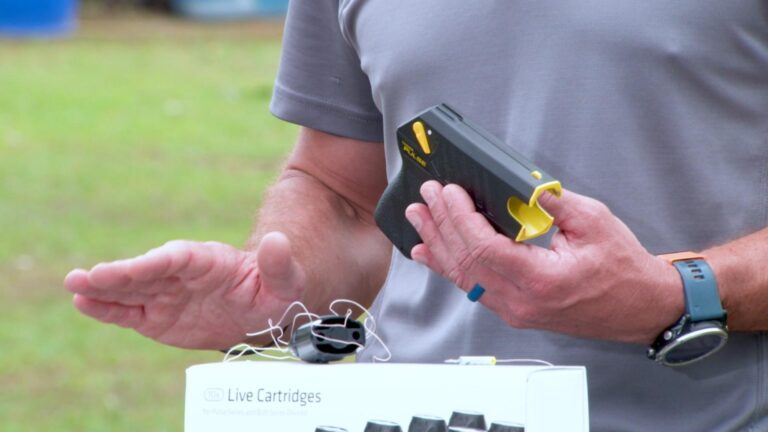Table of Contents
- Stun Gun Deployment Examined in Context of Rodney King Incident
- Forensic Analysis of Use of Force and Impact on Victim
- Legal and Ethical Implications of Stun Gun Application
- Policy Recommendations for Law Enforcement Tactical Use
- In Conclusion
Stun Gun Deployment Examined in Context of Rodney King Incident
The deployment of stun guns during law enforcement interventions has been critically analyzed in light of the Rodney King incident, highlighting the complexities involved in controlling volatile confrontations. The incident underscored the necessity for clear protocols governing the use of less-lethal weapons, particularly stun guns, to minimize both the intensity and duration of physical altercations without escalating harm. Experts argue that while stun guns are intended to incapacitate temporarily, their effectiveness largely depends on the skill and judgment of the officers applying them under high-stress conditions.
Key factors considered in the review of stun gun deployment include:
- The situational context: Evaluating whether the threat level justified stun gun usage over other interventions
- The timing and duration: Assessing how prolonged application affects both compliance and potential injuries
- Training and protocols: Reviewing officer preparedness and adherence to guidelines across departments
This thorough examination serves to inform ongoing policy adjustments aimed at ensuring that stun guns function as a measured response tool rather than a catalyst for excessive force, striving for a balance between public safety and civil rights protections.
Forensic Analysis of Use of Force and Impact on Victim
The forensic examination of the stun gun deployment in the Rodney King incident reveals critical insights into both the tactical application and physiological consequences of this less-lethal weapon. Experts emphasized that the timing, placement, and duration of the electrical charges played a pivotal role in the victim’s response and subsequent injury patterns. Detailed analysis of medical reports confirmed the presence of localized muscular contractions and temporary nerve disruption consistent with the stun gun’s electrical output, illustrating the immediate impact on motor functions without causing lasting neurological damage.
Key findings from the review highlight several important considerations:
- Effectiveness vs. Risk: While the stun gun was effective in incapacitating the victim momentarily, forensic experts underscored the potential for unpredictable secondary injuries, such as falls or contusions resulting from sudden loss of control.
- Forensic Evidence Integrity: Meticulous documentation and preservation of stun gun marks and electrical burn sites proved essential for reconstructing the sequence of events.
- Impact Assessment: The physiological impact was carefully correlated with witness testimonies to evaluate the proportionality and necessity of the force used.
Legal and Ethical Implications of Stun Gun Application
The deployment of stun guns in law enforcement, particularly during high-profile cases like the Rodney King incident, raises significant legal and ethical questions. Central to this debate is how such devices align with constitutional rights and standards of reasonable force. The use of stun guns must be carefully scrutinized under the Fourth Amendment, which guards against unlawful searches and excessive force. Courts have grappled with whether the application of stun guns constitutes a proportional and justified response to perceived threats, emphasizing transparency and accountability in each deployment.
Ethical considerations also extend beyond legal frameworks, encompassing concerns about potential abuse and long-term physical harm. Law enforcement agencies are urged to implement comprehensive training programs that stress:
- Clear guidelines for stun gun use to prevent unnecessary escalation
- Respect for human dignity even in high-stress arrest scenarios
- Regular review and public reporting of stun gun incidents to build community trust
Balancing officer safety with the protection of suspects’ rights requires ongoing dialogue and reform, ensuring that stun gun application promotes justice rather than controversy.
Policy Recommendations for Law Enforcement Tactical Use
In light of the Rodney King incident review, law enforcement agencies must recalibrate operational protocols surrounding the deployment of stun guns to ensure proportionality and accountability. Clear guidelines should mandate stun gun use only when officers face immediate threats that justify non-lethal force, thereby minimizing unnecessary applications of electrical shock devices. Additionally, comprehensive training programs emphasizing de-escalation techniques prior to deploying stun guns are crucial to prevent escalation in volatile encounters.
Recommended policy enhancements include:
- Mandatory activation of body cameras during any stun gun deployment to closely monitor compliance and provide transparent records.
- Strict reporting requirements detailing the context and aftermath of each stun gun use to aid in departmental reviews and policy refinement.
- Periodic psychological evaluations for officers authorized to carry stun guns, ensuring decision-making capabilities under stress.
- Community involvement in policy formation to foster trust and incorporate public concerns into tactical guidelines.
In Conclusion
In conclusion, the review of stun gun use in the Rodney King incident sheds critical light on law enforcement practices and the implications of non-lethal weapons in high-tension confrontations. As authorities continue to evaluate the appropriateness and impact of such devices, this analysis underscores the importance of accountability and adherence to established protocols. Ongoing scrutiny and informed discussion remain essential to ensure public safety and uphold justice in policing.Check Our Other Blogs
- StunGun – Your Trusted Source for Stun Guns, Laws, and Self-Defense Tips
- PepperSprayLaws – Your Trusted Resource for Pepper Spray Information
- StunGunLaws – Your Trusted Guide to Stun Gun Legality and Safety





